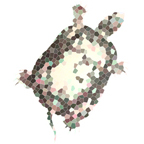 Life imitating art, I get. But life imitating parody?
Life imitating art, I get. But life imitating parody?
Last week Danish researchers reported in the journal PLoS ONE a new technique to track marine mammals in the open ocean through the use of environmental DNA (eDNA). Their research (which bears an uncanny resemblance to the purported parody master work of renowned thalassohodoscatologist Dr. Ostermund I. Fuhl, Ph.D.’s Marine Mammal Tracks and Scats: A Field Guide to North American Species, featured here on the pages of (bio)accumulation in early April), bears down on the Danes’ innovative use of non-invasive oceanic water sampling to detect marine mammal genetic material from feces, shed hair, or skin suspended in the water column.
(photograph © Solvin Zankl)
Working from 15 ml (1 tablespoon) to 50 ml seawater samples collected in both a controlled natural harbor basin and the western Baltic, the Danish researchers were able to detect the presence of harbor porpoise (Phocoena phocoena), whose occurrence and relative densities were verified through static acoustic monitoring of echolocation click trains. Moreover, they were able to detect species like long-finned pilot whale (Globicephala melas) rarer to the area – the first confirmed detection of this species in the Baltic following two unconfirmed visual sightings last summer.
As could be expected, their findings demonstrate that species detection via eDNA in a marine environment is not as reliable due to dilution, dispersal, and salinity. (Fuhl met those challenges head-on through his pioneering ephemerality equivalence equation, the “E³ half-life”, a metric based on post-dispersal colloidal phase stability; rate of sedimentation, aggregation, and flocculation; buoyancy quotient; and dietary composition necessary to determine any given species’ poop-permanence, the time between when a killer whale makes a deep-sea deposit and when it clears the Cordell Bank.) But paired with acoustic and visual surveys (E³ half-life!), eDNA shows potential as one of many future tools in the data dump integral to marine mammal monitoring efforts.


#1 by Melissa on September 7, 2012 - 8:31 am
Woot!
#2 by Molly on September 7, 2012 - 6:43 pm
super cool.
#3 by David Cohen on September 8, 2012 - 5:15 pm
http://tinyurl.com/9ox8ult or
An NYT article of sept 1 by Kirk Johnson:
Tracking a Subtle Scent, a Dog May Help Save the Whales